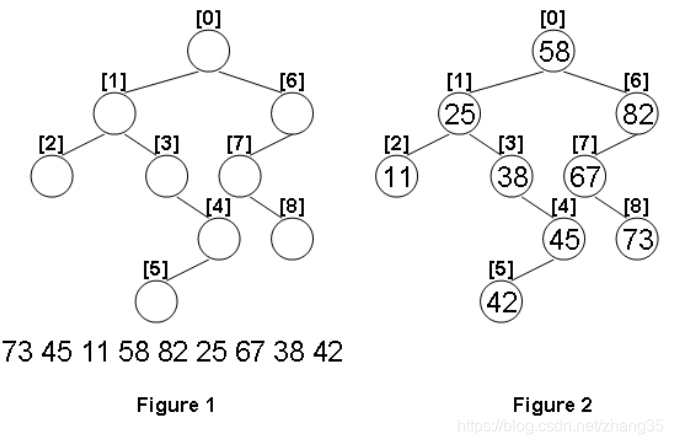题目
A Binary Search Tree (BST) is recursively defined as a binary tree which has the following properties:
The left subtree of a node contains only nodes with keys less than the node’s key.
The right subtree of a node contains only nodes with keys greater than or equal to the node’s key.
Both the left and right subtrees must also be binary search trees.
Given the structure of a binary tree and a sequence of distinct integer keys, there is only one way to fill these keys into the tree so that the resulting tree satisfies the definition of a BST. You are supposed to output the level order traversal sequence of that tree. The sample is illustrated by Figure 1 and 2.

Input Specification:
Each input file contains one test case. For each case, the first line gives a positive integer N (≤100) which is the total number of nodes in the tree. The next N lines each contains the left and the right children of a node in the format left_index right_index, provided that the nodes are numbered from 0 to N−1, and 0 is always the root. If one child is missing, then −1 will represent the NULL child pointer. Finally N distinct integer keys are given in the last line.
Output Specification:
For each test case, print in one line the level order traversal sequence of that tree. All the numbers must be separated by a space, with no extra space at the end of the line.
Sample Input:
9
1 6
2 3
-1 -1
-1 4
5 -1
-1 -1
7 -1
-1 8
-1 -1
73 45 11 58 82 25 67 38 42
Sample Output:
58 25 82 11 38 67 45 73 42
思路
一开始傻乎乎建了个树…然后又傻乎乎计算节点左侧有多少个节点(设为k),那么该节点的值就是第k+1小的值;然后递归计算其左、右孩子的节点,代码如“建树版”所示。
看了柳神的方法:
- 无需建树,只用一个vector模拟树即可,左右孩子可通过下标定位。
- 对二叉搜索树BST中序遍历就能得到升序序列。只需将序列排序后,按中序遍历的次序填入节点中即可;
改写了一遍代码,见“中序遍历版”。
代码
中序遍历版:
#include <iostream>
#include <vector>
#include <queue>
#include <algorithm>
using namespace std;
struct Node{
int l, r, v;
};
void inorder(vector<Node> &nodes, int root, vector<int> &a, int &k){
if (root==-1) return;
inorder(nodes, nodes[root].l, a, k);
nodes[root].v = a[k++];
inorder(nodes, nodes[root].r, a, k);
}
int main(){
int n;
scanf("%d", &n);
vector<Node> nodes(n);
for (int i=0; i<n; i++){
scanf("%d %d", &nodes[i].l, &nodes[i].r);
}
vector<int> a(n);
for (int i=0; i<n; i++){
scanf("%d", &a[i]);
}
sort(a.begin(), a.end());
int k = 0; //记录遍历次序
inorder(nodes, 0, a, k);
//层序遍历了,借助queue,相当于BFS
queue<int> que;
que.push(0);
while (!que.empty()){
int cur = que.front();
que.pop();
if (cur!=0) printf(" ");
printf("%d", nodes[cur].v);
if (nodes[cur].l!=-1) que.push(nodes[cur].l);
if (nodes[cur].r!=-1) que.push(nodes[cur].r);
}
return 0;
}
建树版:
#include <iostream>
#include <vector>
#include <queue>
#include <algorithm>
using namespace std;
struct Node{
Node *l;
Node *r;
int v;
};
//计算以root为根子树节点总数
int totalNodes(Node *root){
int num = 0;
if (root!=NULL) {
queue<Node*> que;
que.push(root);
while (!que.empty()){
root = que.front();
que.pop();
num++;
if (root->l) que.push(root->l);
if (root->r) que.push(root->r);
}
}
return num;
}
void fillNum(Node *root, vector<int> &a, int start){
if (root==NULL) return;
int pos = totalNodes(root->l); //左子树有几个节点
root->v = a[start+pos];
fillNum(root->l, a, start);
fillNum(root->r, a, start+pos+1);
}
int main(){
int n;
scanf("%d", &n);
vector<Node> nodes(n);
for (int i=0; i<n; i++){
int l, r;
scanf("%d %d", &l, &r);
if (l!=-1) nodes[i].l = &nodes[l];
if (r!=-1) nodes[i].r = &nodes[r];
}
vector<int> a(n);
for (int i=0; i<n; i++){
scanf("%d", &a[i]);
}
sort(a.begin(), a.end());
fillNum(&nodes[0], a, 0);
queue<Node*> que;
que.push(&nodes[0]);
a.clear();
while (!que.empty()){
Node *cur = que.front();
que.pop();
a.push_back(cur->v);
if (cur->l) que.push(cur->l);
if (cur->r) que.push(cur->r);
}
printf("%d", a[0]);
for (int i=1; i<n; i++){
printf(" %d", a[i]);
}
return 0;
}





 本文介绍了一种在不构建完整二叉搜索树的情况下,通过中序遍历序列填充节点并进行层序遍历的方法。利用vector模拟树结构,通过节点下标定位左右孩子,实现对二叉搜索树的有效遍历。
本文介绍了一种在不构建完整二叉搜索树的情况下,通过中序遍历序列填充节点并进行层序遍历的方法。利用vector模拟树结构,通过节点下标定位左右孩子,实现对二叉搜索树的有效遍历。
















 2897
2897

 被折叠的 条评论
为什么被折叠?
被折叠的 条评论
为什么被折叠?








